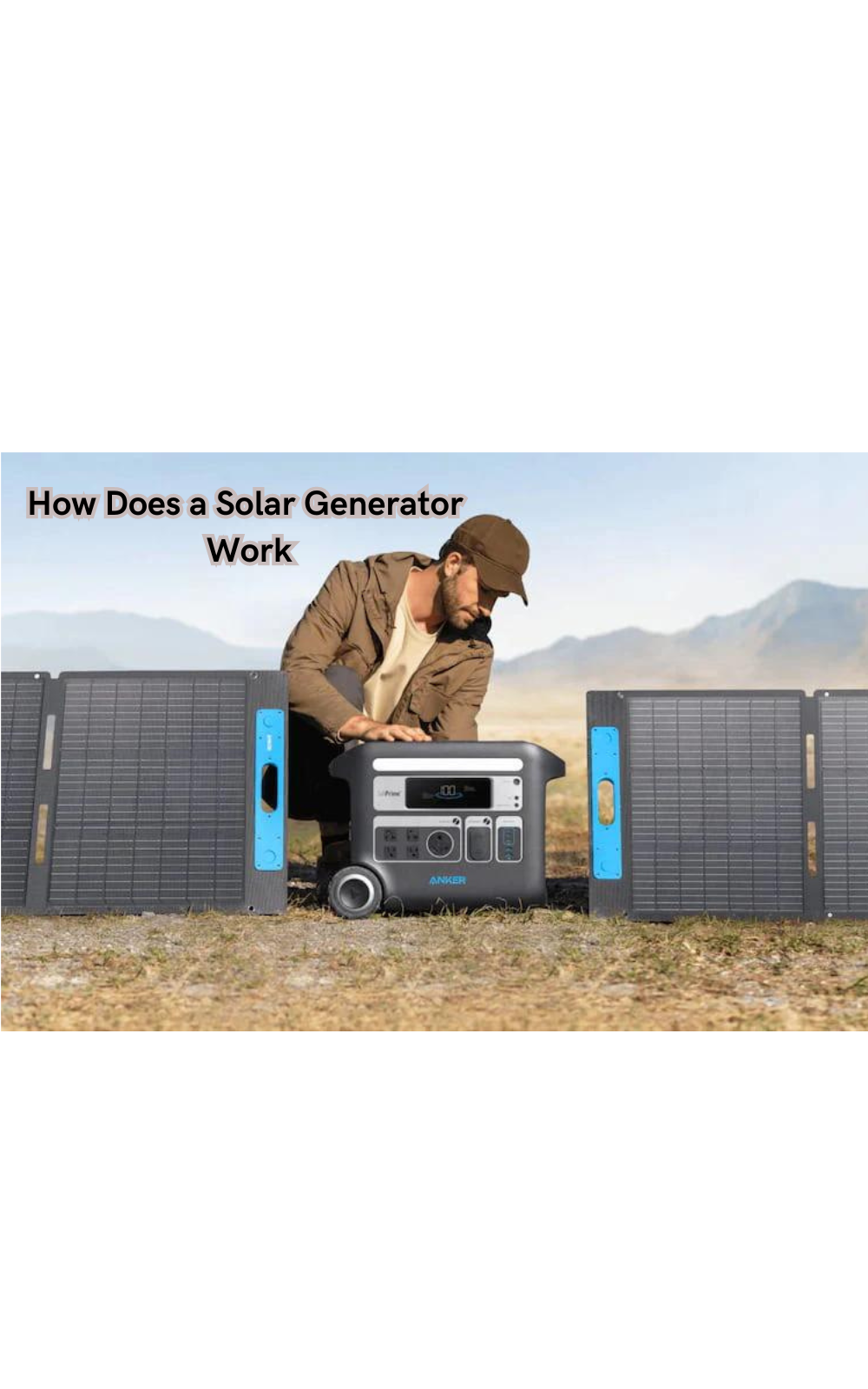How Does a Solar Generator Work
Finally, the inverter converts the DC electricity into usable alternating current (AC) power, making it accessible for powering devices and appliances. This guide will explore in more detail how a solar generator works and its components.

A solar generator harnesses the power of sunlight to provide clean and renewable energy for various applications. By converting sunlight into electricity through photovoltaic panels, solar generators offer a sustainable alternative to traditional fuel-based sources.
These systems comprise solar panels, a charge controller, a battery bank, and an inverter. The panels capture sunlight, which is then converted into direct current (DC) electricity. The charge controller regulates the flow of electricity to the battery bank, where energy is stored for later use.
Finally, the inverter converts the DC electricity into usable alternating current (AC) power, making it accessible for powering devices and appliances. This guide will explore in more detail how a solar generator works and its components.
What is a Solar Generator?
A solar generator is a self-contained energy system that utilizes solar panels to generate electricity. It does not require any external power source, making it an excellent solution for off-grid locations or during emergencies when the traditional power grid is unavailable. Solar power is a renewable and eco-friendly energy source, making solar generators an environmentally conscious choice for consumers.
Solar generators come in different sizes and configurations, depending on their intended use. Small portable systems are ideal for camping trips or charging small electronic devices, while larger models can power household appliances or even a small cabin. Portable solar generator kits often come with folding panels and a compact battery pack, making them easy to transport and set up.
Types of Solar Generators
There are three main types of solar generators: standalone, backup, and grid-tied.
- Standalone Solar Generator
A standalone solar generator is a system that operates independently from the traditional power grid. It is typically used in off-grid locations where there is no access to electricity or as a primary source of power in remote areas. These systems are equipped with battery banks to store excess energy for use when sunlight is unavailable.
- Backup Solar Generator
A backup solar generator is connected to the traditional power grid and acts as a backup source of electricity during power outages. It can also supplement the grid's power supply, reducing overall energy costs. However, these systems do not store excess energy and rely on the grid for continuous operation.
- Grid-tied Solar Generator
A grid-tied solar generator is connected to the traditional power grid and can feed excess energy back into the grid. This type of system is ideal for homes or businesses looking to offset their energy consumption and potentially earn credits from their utility company through net metering.
Components of a Solar Generator
A solar generator consists of four main components: solar panels, a charge controller, a battery bank, and an inverter.
- Solar Panels
Solar panels are the heart of a solar generator. They contain photovoltaic cells that convert sunlight into electrical energy through the photovoltaic effect. These panels come in various sizes and efficiencies, with higher-efficiency panels producing more energy per square meter.
A solar panel is made up of multiple silicon cells connected in series or parallel to generate the desired voltage and current.
- Charge Controller
A charge controller regulates the flow of electricity from the solar panels to the battery bank. It prevents overcharging and ensures that the batteries are charged at their optimum level for a longer lifespan.
Some advanced charge controllers also have features such as maximum power point tracking (MPPT) to maximize energy production. Solar-powered generator systems may also have a built-in charge controller to simplify the setup process.
- Battery Bank
The battery bank stores excess energy produced by the solar panels for later use. It is typically made up of multiple deep-cycle batteries, which can withstand frequent charging and discharging cycles. The size and type of batteries used depend on the system's power requirements.
When solar panels convert sunlight into electricity, any excess energy that is not immediately used by devices or appliances is stored in the battery bank. This works as a power station where the energy can be harnessed at a later time, such as during nighttime or when sunlight is unavailable.
- Inverter
An inverter converts the DC electricity from the battery bank into usable AC power. This allows the solar generator to power devices and appliances that require AC electricity. Inverters come in different sizes and types, with some models having additional features like surge protection or multiple outlets.
How Does a Solar Generator Work?
Solar generators work by harnessing the power of sunlight and converting it into electricity that can be used for various applications. Here's a step-by-step breakdown of how they work:
- Solar panels absorb sunlight and convert it into DC electricity through the photovoltaic effect.
- The charge controller regulates the flow of electricity from the solar panels to the battery bank, preventing overcharging.
- The battery bank stores excess energy for later use.
- When electricity is needed, the inverter converts the DC electricity from the batteries into AC power.
- The AC power can then be used to power devices and appliances or fed back into the traditional power grid (in a grid-tied system).
A solar power generator is a reliable and sustainable source of electricity, providing an alternative to traditional fuel-based generators. Gas generators can be loud, emit fumes, and require frequent refueling. Solar generators, on the other hand, operate silently and have no harmful emissions, making them a more environmentally friendly option.
Tips for Using a Solar Generator
Now that you know how a solar generator works, here are some tips for getting the most out of your system:
- Solar panels should be placed in an area with maximum sunlight exposure for optimal energy production.
- Regularly clean and maintain solar panels to ensure maximum efficiency.
- Consider the power requirements of your devices and appliances when choosing a solar generator.
- Use energy-efficient devices to reduce overall energy consumption.
- Consider adding additional battery banks for longer backup power or energy storage capacity.
Benefits of Using a Solar Generator
There are several benefits to using a solar generator, including the following:
Renewable and Eco-friendly:
Solar energy is a renewable energy source, meaning it will never run out. It also does not produce harmful emissions, making it an environmentally friendly option.
Cost-effective:
Once installed, solar generators have minimal operating costs as they rely on sunlight to generate electricity. This can help reduce overall energy expenses in the long run.
Portable and Versatile:
Portable solar generators can be easily transported to any location, making them ideal for camping trips or emergency situations. They also come in various sizes and configurations, allowing users to choose the best option for their specific needs.
Low Maintenance:
Solar generators have few moving parts and require minimal maintenance, reducing the risk of breakdowns and costly repairs. Solar-powered generators also have a longer lifespan than traditional fuel-based generators.
Energy Independence:
With a standalone solar generator, users can have access to electricity even in remote locations without relying on the traditional power grid. Portable power stations can also provide backup power during outages, giving users peace of mind.
Traditional gas-powered generators may still have their place in certain situations, but the many benefits of solar generators make them a popular and practical choice for homes and businesses alike.
How to Choose Best Solar Generator
When choosing a solar generator, it's important to consider your specific energy needs and the type of system that will best fit them. Factors such as the size and efficiency of solar panels, battery capacity, and inverter power output should also be taken into account. You may also want to consider the portability of the system if you plan on using it for outdoor activities or emergencies.
It's recommended to do thorough research and compare different models before making a decision. Ultimately, the best solar generator for you will depend on your individual needs and preferences. With the right setup, a solar generator can provide sustainable and reliable power for years to come. So, it is important to choose carefully according to your needs.
FAQs
How many hours will a solar generator run?
The runtime of a solar generator depends on its capacity and the amount of energy being used. Some portable solar generators can run for 5-6 hours, while larger systems may be able to run for several days.
Can a solar generator power an entire house?
It is possible for a large and efficient solar generator to power an entire house, but it would require careful planning and a significant investment. It's more common for solar generators to be used as backup power sources or to supplement traditional electricity usage rather than completely replacing it.
Do solar generators work at night?
Solar panels cannot generate electricity without sunlight, so a solar generator will not work at night. However, some systems come with battery banks that can store excess energy generated during the day for use at night.
Can I connect my solar generator to the traditional power grid?
Grid-tied solar generators can be connected to the traditional power grid, allowing users to sell back excess energy to the utility company and potentially receive credits on their electricity bill. However, this type of system may require additional equipment and permits to be installed properly.
Conclusion
In conclusion, the functioning of a solar generator encapsulates the brilliance of renewable energy technology and its transformative impact on sustainable power generation.
By harnessing the inexhaustible power of the sun, solar generators exemplify a clean and eco-friendly solution to meet energy needs. The process of converting sunlight into usable electricity through photovoltaic panels, storage in a battery system, and conversion to alternating current via an inverter showcases the efficiency and versatility of solar power systems.
Embracing solar generators not only reduces reliance on fossil fuels but also contributes to mitigating environmental impact. As we continue to embrace renewable energy solutions, the widespread adoption of solar generators underscores a promising future where clean energy plays a pivotal role in shaping a greener and more sustainable world.
